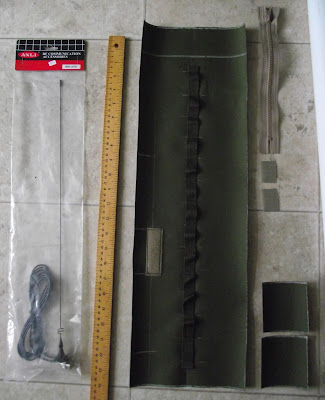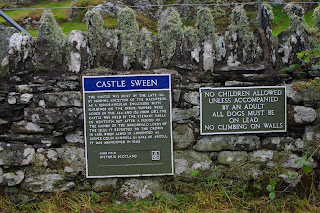 |
| Finished Pouch Attached to the Cubist Escape |
The Cubist Escape has become a pack to hold radio gear. So, for all my friends who are operating (or are planning to operate) HAM radios in the field.....this project is dedicated to you. Today, we built a lightly armoured HAM Radio Antenna Carrier.
Read on for more details......I will try to post the plans, upside right this time.
Yes, the plans are now a part of this post and they arrived exactly where I needed them. That was a nice change.
So, if you have a portable HAM radio unit like a Baofeng or something similar, then you probably have a magnetic base antenna to attach to the roof of your vehicle to increase the range of both receiving and transmitting. But, how do you safely transport said antenna when it is not on the roof?? You need a pocket or pouch that you can attach to your radio ruck that both carries and protects your antenna from unintended abuse while in transit.
 |
| The Plans |
To this end, I give to you the HAM Radio Antenna Pouch for your ruck. For armour, we have a piece of 2" O.D. PVC Vacuum Pipe cut a wee bit longer than the height of your antenna. Now, you Red/Green fans can go ahead and complete this project with just Duct Tape, but the rest of us want function and fashion. To attach this PVC pipe to the pack we need to build a fabric pouch to hold the pipe in place. The PVC pipe is tough enough and light enough to both protect and hold its shape.
I am currently out of my normal building material 1000 denier Cordura, so this project was built with 600 denier PVC backed pack cloth, tough enough and then some for this project. In fact, if you had ripstop parachute cloth, that would work, especially if your mission requires extreme light weight gear. The PVC pipe is doing all the real work, the fabric is only acting as a means to interface the pipe to your ruck, in a convenient way.
We need a couple of measurement before we get too far in the layout process. First, how tall is your antenna?? Second, will your magnetic base fit inside a 2" O.D. PVC Vacuum Pipe?? Third, what is the outside circumference of the pipe you are using?? And finally, how will you attach this pouch to your ruck??
#1: Antenna: Nagoya model: UT-102UV is about 12" tall.
#2: Yes, the base will fit inside the PVC pipe.
#3: Outside circumference = 6 3/8"
#4: Basic 3/4" webbing and Velcro, through the MOLLE style webbing on the side of the ruck.
 |
| Start |
 |
| Layout |
I start with a 15" piece of the 2" PVC pipe. The fabric required must be 7 1/2" x 16 1/2" to cover the tube and allow enough room for seams.
The zipper will hold the top cap to the fabric lower. The top cap only needs to be 2" x 7 1/2".
 |
| Ready to Assemble |
 |
| Progressing Nicely |
The ends of the fabric will be closed with either a single or double layer of pack cloth. Since, this antenna is so lightweight, I opted for a single layer top and bottom.
In case I need to share this antenna with anyone, I wanted a webbing strip to feed anchor straps through. This was achieved by adding a 3/4" webbing sewn at 1 1/2" intervals down the centre line of the pouch. The anchor webbing and Velcro be inset about 1/2" from the edge, so you can sew past it when sewing the main seam. You can do this on either side, it depends which side of your ruck you want your antenna pouch on. This one ends up to mount on the left side of the Cubist Escape. Next one will need to be the opposite to mount on the right side of the Cubist Escape.
 |
| Basic Shape Achieved |
 |
| Ends Attached |
 |
| Insert PVC Pipe |
 |
| Attach to Pack |
Once, all the outside work is completed, it is time to assemble your pouch.
Start with the main seam. Goodside to goodside, sew down the seam. I use the edge of my machine's foot to gauge the allowance. I sew tight allowances, so for me on a project like this, a bit over an inch more than the size I want will do. If you use large seam allowances, you may need to add more when you layout your design onto your fabric.
This first project I had to design and build the proto-type. Now, that I know the seams work; the next one will utilize inside seams for the ends. Once I had reversed the material I knew I did not want to do that twice more.
All-in-all, I am quite happy with how this pouch turned out. It fit on the Cubist Escape well. And, I believe this pouch will protect my antenna well. My only concern with outside seams on the top and bottom of the pouch is that rain or snow may collect and seep through.....although, I am not sure the antenna would be affect by some moisture.
Well, when you need gear and cannot find or afford it.....you may as well make it.
Until next time, design and built something!!!

























































